- Arms
- Arms I, short, about 33-35% of ML.
- Arms II and III subequal, about 43-48% of ML.
- Arms IV, long and broad, about 70-75% of ML.
- Arms IV with relatively thin, narrow trabeculate protective membranes on ventral border and broad, thick membranes dorsally (see photograph).
- Largest suckers of all arms approximately equal in size.
- Arm suckers with 10-12 slender, pointed teeth on distal margin; lateral most teeth broader, somewhat truncate.
- Tentacles
- Tentacle whip-like, circular in cross-section.
- Club length about 40% of tentacle length.
- Club covers about 40% of tentacle circumference within a few mm of club base; near tip club covers about 90% of tentacle circumference.
- Widest region of club (ca. 1/3 from base) with about 17 suckers across.
- Head
- Eye large, occupies virtually entire side of head (see eye in photograph under "Photophores" above).
- Funnel pocket present.
- Olfactory organ short, cyclindrical with lightly pigmented, thick stalk and unpigmented head; head diameter equal to or slightly smaller than stalk diameter.
- Funnel locking-apparatus
- Tragus large.
- Antitragus flat, not undercut.
- Mantle
- Mantle long and slender; muscular portion terminates posteriorly at 52% of ML (including tail) from the anterior end (i.e., mantle muscle overlaps the anterior third of the fin).
- No tubercles in subadults.
- Fins
- Fins longer than combined width.
- Pigmentation
- Mantle, head and arms brown-red color.
- Much pigment in typical chromatophores.
- Pigmentation of the head mostly in chromatophores (photograph below of portion of ventral surface of head - note eye lens and tip of funnel).
- Tentacle with light epithelial pigmentation at base (photograph below); mostly unpigmented.
- Aboral surfaces of arms with mostly pigmentation in chromatophores; oral surfaces with mostly epithelial pigmentation (see photograph of arms above).
- Measurements and counts
Figure. Photograph of two arms of E. famelica, preserved. The broader arm IV (lateral view) shows the wide tentacle sheath (horizontal arrow) and a trabecula (lower vertical arrow) of the ventral protective membrane; the more slender arm (oral view of a more dorsal arm, near the tip) shows trabeculae (upper vertical arrow) and a protective membrane. An apparent parasite (oblique arrow) is embedded in arm IV.
Figure. - Oral view of preserved arm suckers of E. famelica, neotype. Photographs by R. Young.
Figure. Ventral view of olfactory organ of E. familica, preserved, neotype. Photograph by R. Young.
Figure. Funnel/mantle locking-aparatus of E. famelica, Hawaiian waters. Left - Frontal view of funnel component. Left-center (two photographs) - Funnel component cut along the midline then folded back to show the longitudinal section of the lock; in making this section, the tip of the tragus was cut off. (note the highly vacuolated cartilage). Right-center - Frontal view of mantle component. Right - Side view of mantle component. Except for the left photograph, all were stained with methylene blue. Photographs by R. Young.
Figures. Ventral views of the posterior mantle of E. famelica, neotype, preserved. Left - Enlargement from the title photograph showing individual chromatophores within a portion of the ventral-mantle skin near the fins. Right - View slightly posterior to left photograph (note fin in background), showing, more clearly, the reticulate white tissue that lies beneath the outer surface of the skin and the large chromatophore within the center of each circlet of white tissue. A small piece of skin torn free and turned over is seen in the upper center of the photograph. Photographs by R. Young.
Figure. Ventral view of head and tentacle stalk base of E. famelica, preserved, neotype. Photograph by R. Young.
| Squid | Neotype | ||
| Sex | Immature female | Immature female | Immature male |
| Mantle length (incl. tail) | 241 | 140 | 180 |
| Length of muscular mantle | 125 | ||
| Mantle width | 39 | ||
| Tail length | 25 | ||
| Fin length | 135 | ||
| Fin width | 113 | ||
| Head length* | 25 | ||
| Head width | 30 | ||
| Eye diameter | 20 | ||
| Eyelid photophore length / width | 2.0 / 0.6 | 4.2 / 3.0 | |
| Arm I Length: L / R | 71 / 75 | ||
| Arm II Length | 103 / 102 | ||
| Arm III Length | 94 / 93 | ||
| Arm IV Length | 163 / 154 | ||
| Arm II sucker diameter | 1.7 | ||
| Arm III sucker number | ca. 128 | ||
| Arm IV sucker number | ca. 93 | ||
| Tentacle Length | 350 / 368 | ||
| Club Length | 150 / 143 | ||
| Club sucker diameter | 0.36 mm |

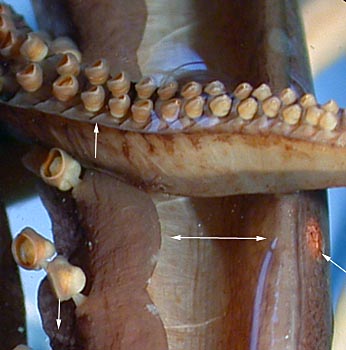
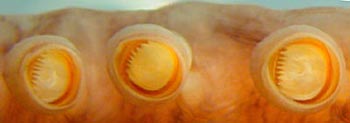
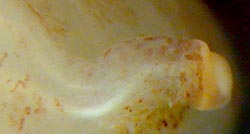
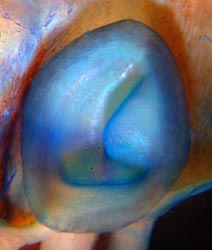
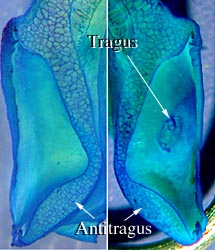
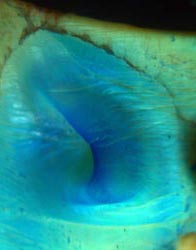
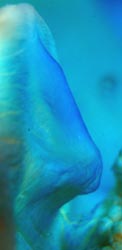
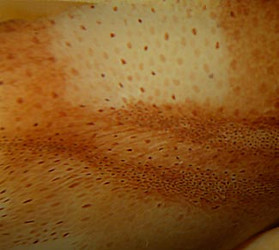
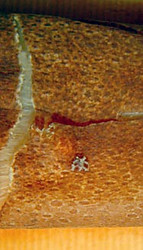
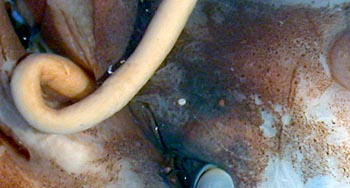




 Go to quick links
Go to quick search
Go to navigation for this section of the ToL site
Go to detailed links for the ToL site
Go to quick links
Go to quick search
Go to navigation for this section of the ToL site
Go to detailed links for the ToL site